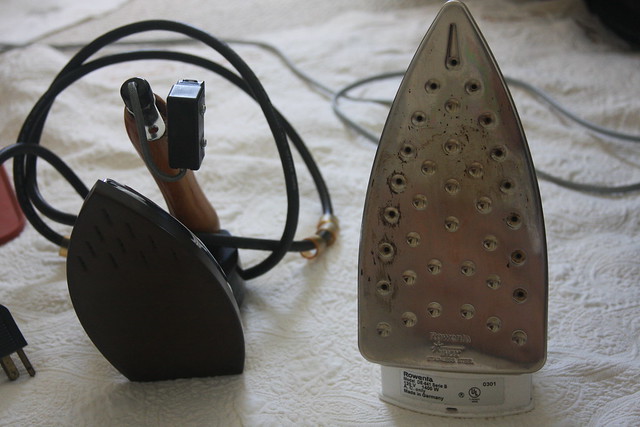What's so Great about those Commercial Gravity Feed Irons? Naomoto

*** Please disregard the Rowenta needing a cleaning.
Positive
+ They put out magnificent steam
+ They reach high temperatures, which I found best for stubborn cottons
+ With the reservoir you aren't constantly stopping and filling up, so there is opportunity for uninterrupted pressing.
+ / -They have a narrow sole (8" x 4" vs 9" x 4 3/4" on the Rowenta), which makes getting into tight areas easy
+ Programmable to exact temperature settings
+ They are made to last
+ The steam holes are concentrated at the tip
This allows you to hit an area with steam and use the back of the plate to dry it.
+ Less time ironing, because one pass is enough
Negatives
- They are expensive, the current Naomoto NY-58 is at least $500.00 (if you can find them)
- They weigh 6 lbs (good and bad), even though you'll find you'll need less time to iron, you will be lifting a heavier weight (than a home iron by about 2lbs).
- / +The sole plate is smaller, so you will only be able to iron small areas
- They may not completely die on you but you may find yourself "maintaining" them.
The thermostat has been replaced twice on this unit, and there are other parts that can go bad as well.
- They are costly to repair (at least in this area, unless you are handy with electronics.....)
- Original parts are becoming more difficult to find online
- You will need to buy a new filter on occasion (some of mine have lasted 2 -3 years
(it is based on use and water quality, and will run you $30 a pop)
- Space -You need a dedicated area to place the tank and attached iron when you aren't using it.
You can't store it on it's side when full.
- You may need additional insulation for the handle
This model's handle gets HOT, not sure if it's a problem with the thermostat or if it's just like that.
Later models have insulated handles which apparently don't have this issue.
- You may need additional insulation for beneath the Ironing pad
Some users place the pad on a ceramic base or wood base to keep the iron lifted, they have reported that
the silicone pad (which has a metal component), gets hot as well. I've never found that to be the case with
mine being vintage it might have been made a little better, maybe the silicone on my pad is thicker.
- You can not rest the iron on it's back, so you will need an area to keep it on it's pad taking up valuable
ironing space
The biggest downside for me is that it is getting more difficult to find parts, and it is expensive to repair, and the handle on this model gets so hot, it's difficult to use. I'm not sure what is happening with the brand, but it looks to me as if they are either no longer manufacturing, or no longer importing the Naomoto irons. So why do people buy them?
They really are that good and the higher temperatures and steam means you can knock out practically any wrinkle you meet. Once you learn how to use it properly it gives you professional results. Of course this isn't the only option, there are other industrial irons on the market... like the Consew....

Comments